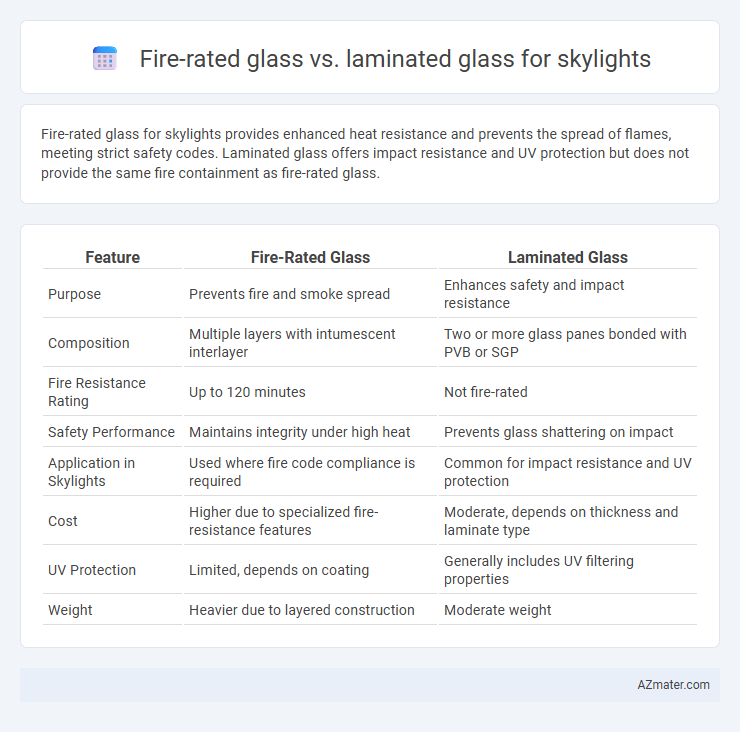Fire-rated glass for skylights provides enhanced heat resistance and prevents the spread of flames, meeting strict safety codes. Laminated glass offers impact resistance and UV protection but does not provide the same fire containment as fire-rated glass.
Table of Comparison
| Feature | Fire-Rated Glass | Laminated Glass |
|---|---|---|
| Purpose | Prevents fire and smoke spread | Enhances safety and impact resistance |
| Composition | Multiple layers with intumescent interlayer | Two or more glass panes bonded with PVB or SGP |
| Fire Resistance Rating | Up to 120 minutes | Not fire-rated |
| Safety Performance | Maintains integrity under high heat | Prevents glass shattering on impact |
| Application in Skylights | Used where fire code compliance is required | Common for impact resistance and UV protection |
| Cost | Higher due to specialized fire-resistance features | Moderate, depends on thickness and laminate type |
| UV Protection | Limited, depends on coating | Generally includes UV filtering properties |
| Weight | Heavier due to layered construction | Moderate weight |
Introduction to Skylight Glazing Options
Skylight glazing options primarily include fire-rated glass and laminated glass, each offering distinct safety and performance benefits. Fire-rated glass provides enhanced resistance to high temperatures and fire spread, essential for meeting building fire codes and protecting occupants. Laminated glass offers impact resistance and superior sound insulation while maintaining clarity, making it ideal for energy efficiency and security in skylight installations.
What is Fire-Rated Glass?
Fire-rated glass is specially engineered to resist high temperatures and prevent the spread of fire and smoke, making it essential for skylights in buildings requiring fire safety compliance. It typically consists of multiple layers, including intumescent interlayers that expand when exposed to heat, creating an insulating barrier. This glass type maintains structural integrity during a fire, unlike laminated glass, which primarily provides impact resistance and UV protection but lacks certified fire-retardant properties.
What is Laminated Glass?
Laminated glass consists of two or more layers of glass bonded together with an interlayer, typically made of polyvinyl butyral (PVB), providing enhanced safety and noise reduction. When used in skylights, laminated glass prevents shards from scattering upon breakage, maintaining structural integrity and offering UV protection. Unlike fire-rated glass, laminated glass does not provide fire resistance but excels in impact resistance and durability for everyday exposure.
Key Safety Standards for Skylights
Fire-rated glass for skylights meets stringent safety standards such as UL 972 and ASTM E119, ensuring resistance to high temperatures and preventing fire spread. Laminated glass, while offering impact resistance and enhanced security, typically complies with safety standards like EN 356 and ANSI Z97.1 but lacks fire-resistance certification critical for skylight applications requiring fire protection.
Fire Protection: Fire-Rated Glass Benefits
Fire-rated glass provides enhanced fire protection for skylights by withstanding extreme temperatures and preventing the spread of flames and smoke, ensuring safe evacuation routes. Unlike laminated glass, fire-rated glass maintains its structural integrity during a fire, meeting stringent building codes and fire safety standards. Its ability to block radiant heat reduces fire damage to surrounding materials, making it an optimal choice for fire-resistant skylight applications.
Impact Resistance: Advantages of Laminated Glass
Laminated glass offers superior impact resistance compared to fire-rated glass, making it an ideal choice for skylights exposed to potential debris or severe weather conditions. The interlayer in laminated glass holds shards together upon impact, reducing the risk of dangerous breakage and enhancing overall safety. This durability also contributes to better protection against falls and accidental impacts, extending the lifespan and reliability of skylight installations.
Energy Efficiency Comparison
Fire-rated glass and laminated glass for skylights differ significantly in energy efficiency, with laminated glass typically offering superior thermal insulation due to its multi-layer construction and interlayer materials that reduce heat transfer. Fire-rated glass prioritizes fire resistance and structural integrity under high temperatures, often resulting in higher thermal conductivity and less energy-efficient performance compared to laminated glass. Choosing laminated glass for skylights can enhance energy savings by minimizing heat loss and solar heat gain, contributing to lower HVAC costs and improved indoor comfort.
Cost Considerations for Skylight Projects
Fire-rated glass for skylights typically incurs higher upfront costs due to specialized materials and certified performance standards required to withstand high temperatures and prevent fire spread. Laminated glass offers a cost-effective alternative with enhanced safety features, such as impact resistance and noise reduction, while being more affordable and easier to source for standard skylight projects. Budget planning for skylight installations should weigh the long-term benefits of fire-rated glass against the immediate savings and functional advantages presented by laminated glass options.
Maintenance and Longevity
Fire-rated glass for skylights offers superior durability under extreme heat and maintains structural integrity during fire events, ensuring long-term safety with minimal maintenance. Laminated glass, while providing enhanced impact resistance and UV protection, may require more frequent inspections and potential resealing to prevent delamination or moisture ingress over time. Choosing fire-rated glass optimizes longevity and reduces maintenance frequency in critical safety applications such as skylights.
Choosing the Right Glass for Skylights
Fire-rated glass for skylights offers superior heat resistance and prevents the spread of flames, making it essential for buildings requiring fire safety compliance. Laminated glass enhances impact resistance and reduces UV transmission, improving durability and energy efficiency while providing noise reduction. Selecting the right glass depends on specific safety regulations, climate considerations, and desired performance features tailored to the skylight's location and building design.

Infographic: Fire-rated glass vs Laminated glass for Skylight
 azmater.com
azmater.com